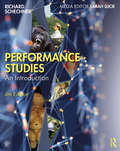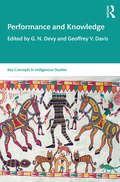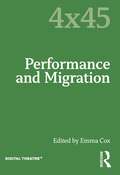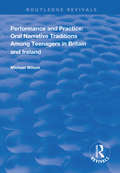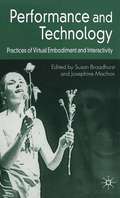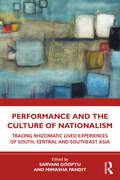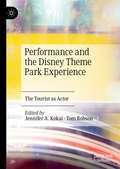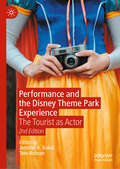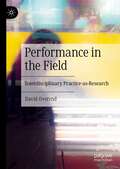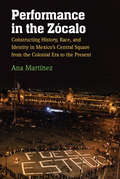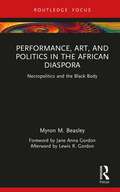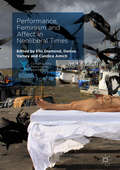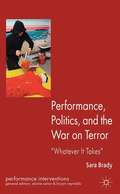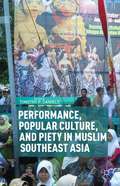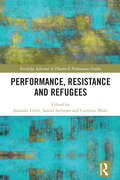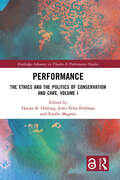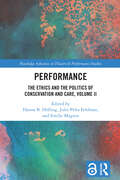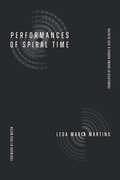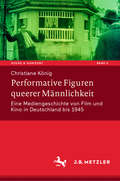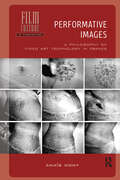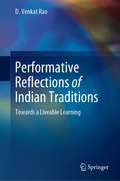- Table View
- List View
Performance Studies: An Introduction
by Richard SchechnerRichard Schechner's pioneering textbook is a lively, accessible overview of the full range of performance, with primary extracts, student activities, key biographies, and over 200 images of global performance. The publication of Performance Studies: An Introduction was a defining moment for the field. This fourth edition has been revised with two new chapters, up-to-date coverage of global and intercultural performances, and an in-depth exploration of the growing international importance of Performance Studies. Among the book’s topics are the performing arts and popular entertainments, rituals, play and games, social media, the performances of the paleolithic period, and the performances of everyday life. Supporting examples and ideas are drawn from the social sciences, performing arts, poststructuralism, ritual theory, ethology, philosophy, and aesthetics. Performance Studies: An Introduction features the broadest and most in-depth analysis possible. Performance Studies: An Introduction is the definitive overview for undergraduates at all levels and beginning graduate students in performance studies, the performing arts, and cultural studies. This new edition is also supported by a fully updated companion website, offering a variety of interactive resources, teaching tools, and research links.
Performance and Knowledge (Key Concepts in Indigenous Studies)
by G. N. Devy Geoffrey V. DavisPart of the series Key Concepts in Indigenous Studies, this book focuses on the concepts that recur in any discussion of nature, culture and society among the indigenous. This final volume in the five-volume series deals with the two key concepts of performance and knowledge of the indigenous people from all continents of the world. With contributions from renowned scholars, activists and experts across the globe, it looks at issues and ideas of the indigenous peoples in the context of imagination, creativity, performance, audience, arts, music, dance, oral traditions, aesthetics and beauty in North America, South America, Australia, East Asia and India from cultural, historical and aesthetic points of view. Bringing together academic insights and experiences from the ground, this unique book, with its wide coverage, will serve as a comprehensive guide for students, teachers and scholars of indigenous studies. It will be essential reading for those in social and cultural anthropology, tribal studies, sociology and social exclusion studies, cultural studies, media studies and performing arts, literary and postcolonial studies, religion and theology, politics, Third World and Global South studies, as well as activists working with indigenous communities.
Performance and Migration (4x45)
by Emma CoxThis third volume in the 4x45 series addresses some of the most current and urgent performance work in contemporary theatre practice. As people from all backgrounds and cultures criss-cross the globe with an ever-growing series of pushes and pulls guiding their movements, this book explores contemporary artists who have responded to various forms of migration in their theatre, performance and multimedia work. The volume comprises two lectures and two curated conversations with theatre-makers and artists. Danish scholar of contemporary visual culture, Anne Ring Petersen, brings artistic and political aspects of ‘postmigration’ to the fore in an essay on the innovations of Shermin Langhoff at Berlin’s Ballhaus Naunynstraße, and the decolonial work of Danish-Trinidadian artist Jeannette Ehlers. The racialised and gendered exclusions associated with navigating ‘the industry’ for non-white female and non-white non-binary artists are interrogated in Melbourne-based theatre scholar Paul Rae’s interview with two Australian performers of Indian heritage, Sonya Suares and Raina Peterson. UK playwrights Joe Murphy and Joe Robertson of Good Chance Theatre discuss their work in dialogue, and with their colleague, Iranian animator and illustrator Majid Adin. Emma Cox’s essay on Irish artist Richard Mosse’s video installation, Incoming, discusses thermographic ‘heat signatures’ as a means of seeing migrants and the imperative of envisioning global climate change. An accessible and forward-thinking exploration of one of contemporary performance’s most pressing influences, 4x45 | Performance and Migration is a unique resource for scholars, students and practitioners of Theatre Studies, Performance Studies and Human Geography.
Performance and Practice: Oral Narrative Traditions Amongst Teenagers in Britain and Ireland (Routledge Revivals)
by Michael WilsonFirst published in 1997, this volume takes a dive into methods of teenage storytelling, including questions of believability, fashionability, rebellious spirit, the supernatural, personal narratives and riddles, along with an archive of texts collected by the author intended to illuminate and inform the analysis. It builds on the extensive work of Peter and Iona Opie on the same subject involving children of all ages and explores connections to folklore and narrative variations from a performative perspective. Michael Wilson shares their findings that children continue to cherish their traditional lore in the face of modern technological entertainment. His study is similar in responding to the poor status and even denial of a teenage narrative tradition, inspired by both short and extended narratives which he experienced daily. Wilson hoped to give academic depth and breadth to the storytelling renaissance and giving teenage storytellers their rightful place in our ongoing oral narrative tradition.
Performance and Technology: Practices of Virtual Embodiment and Interactivity (Palgrave Studies In Performance And Technology Ser.)
by Susan Broadhurst Josephine MachonThis collection interrogates the interaction between new technologies and performance practice, linking the sensuous contact that must exist between the physical and virtual, together with the resultant corporeal transformation. It features writings from international contributors who specialize in digital art and performance practices.
Performance and the Culture of Nationalism: Tracing Rhizomatic Lived Experiences of South, Central and Southeast Asia
by Sarvani Gooptu and Mimasha PanditThis book studies the intersection of performance and nationalism in South Asia.It traces the emergence of the culture of nationalism from the late nineteenth century through to contemporary times. Drawing on various theatrical performance texts, it looks at the ways in which performative narratives have reflected the national narrative and analyses the role performance has played in engendering nationhood. The volume discusses themes such as political martyrdom as performative nationalism, the revitalisation of nationalism through new media, the sanitisation of physical gestures in dance, the performance of nationhood through violence in Tajiki films, as well as K-Pop and the new northeastern identity in India. A unique contribution to the study of nationalism, this book will be useful for scholars and researchers of history, theatre and performance studies, cultural studies, postcolonial studies, modern India, Asian studies, political studies, social anthropology and sociology.
Performance and the Disney Theme Park Experience: The Tourist as Actor
by Jennifer A. Kokai Tom RobsonThis book addresses Disney parks using performance theory. Few to no scholars have done this to date—an enormous oversight given the Disney parks’ similarities to immersive theatre, interpolation of guests, and dramaturgical construction of attractions. Most scholars and critics deny agency to the tourist in their engagement with the Disney theme park experience. The vast body of research and journalism on the Disney “Imagineers”—the designers and storytellers who construct the park experience—leads to the misconception that these exceptional artists puppeteer every aspect of the guest’s experience. Contrary to this assumption, Disney park guests find a range of possible reading strategies when they enter the space. Certainly Disney presents a primary reading, but generations of critical theory have established the variety of reading strategies that interpreters can employ to read against the text. This volume of twelve essays re-centers the park experience around its protagonist: the tourist.
Performance and the Disney Theme Park Experience: The Tourist as Actor, 2nd Edition
by Jennifer A. Kokai Tom RobsonMost scholars and critics deny agency to the tourist in their engagement with the Disney theme park experience. The vast body of research and journalism on the Disney &“Imagineers&”—the designers and storytellers who construct the park experience—leads to the misconception that these exceptional artists puppeteer every aspect of the guest&’s experience. This anthology, now in its second edition, re-centers the park experience around its protagonist: the tourist, and addresses the Disney Parks using performance theory, an approach few to no scholars had used prior to the first edition. The authors of the individual essays, as well as the Introduction by Kokai and Robson, and an Afterword by world renowned tourism and performance expert Susan Bennett, recognize the inherently complicated nature of Disney. Many of the contributors consider themselves Disney fans, but also recognize the potentially problematic aspects of Disney parks. This collection permits both perspectives to exist side by side, informing rather than contradicting each other.
Performance in a Time of Terror: Five Sinhala Plays from Sri Lanka
by Ranjini Obeyesekere Kanchuka DharmasiriThis volume is a collection of five Sinhala plays, translated into English, which were written and performed during the most violent phase of modern Sri Lankan history. Ranjini Obeyesekere’s translation of these five well-known and celebrated plays by K. B. Herath, Prasannajith Abeysuriya, Dhananjaya Karunarathne, Prasanna Jayakody and Rajitha Dissanayake highlights and explores the dynamic period of Sri Lankan theater and performance arts in the 1980s and 1990s. The plays in this collection offered a political space for criticism, introspection, discussion and protest during a time of suppression of voices, political violence and terror. Audiences flocked to the theater to watch plays produced by talented dramatists and artists who were experimenting with forms and themes under extremely challenging circumstances, shoe-string budgets and strict censorship. Kanchuka Dharmasiri’s introduction to the volume further details the history and socio-political contexts of the theater of this period, discussing themes such as dissent, identity and the brutal power of the state. She also looks at the unique formal elements employed in these plays as well as their influence and reach. This volume is a significant addition to the growing corpus of Sinhala literature in translation. It will be an essential read for scholars and researchers of literature, performance studies, cultural studies, and the politics and history of Sri Lanka.
Performance in the Field: Interdisciplinary Practice-as-Research
by David OverendThis book makes a compelling case for ‘performance fieldwork’ as a vital new approach to interdisciplinary collaboration. Refocussing the histories and practices of field research, it shows how creative methods and artistic processes can contribute to an embodied and situated knowledge of complex landscapes and environments. The book brings together case studies of innovative research in the fields of ecology, clubbing, heritage, mobility and deep time, which took place in the United Kingdom between 2009 and 2021. These accessible and engaging field notes connect to international and intercultural contexts, with attention to alternative experiences and perspectives throughout. Together, they provide a critically informed ‘toolbox’ of playful and exploratory strategies for working with a diverse range of urban and rural sites – including a river, a museum, a nightclub, a motorway and a cave. This is a timely methodology that reaches across disciplines to demonstrate how performance continually plays out ‘in the field’.
Performance in the Zócalo: Constructing History, Race, and Identity in Mexico's Central Square from the Colonial Era to the Present
by Ana MartínezFor more than five centuries, the Plaza Mayor (or Zócalo) in Mexico City has been the site of performances for a public spectatorship. During the period of colonial rule, performances designed to ensure loyalty to the Spanish monarchy were staged there, but over time, these displays gave way to staged demonstrations of resistance. Today, the Zócalo is a site for both official government-sponsored celebrations and performances that challenge the state. Performance in the Zócalo examines the ways that this city square has achieved symbolic significance over the centuries, and how national, ethnic, and racial identity has been performed there. A saying in Mexico City is “quien domina el centro, domina el país” (whoever dominates the center, dominates the country) as the Zócalo continues to act as the performative embodiment of Mexican society. This book highlights how particular performances build upon each other by recycling past architectures and performative practices for new purposes. Ana Martínez discusses the singular role of collective memory in creating meaning through space and landmarks, providing a new perspective and further insight into the problem of Mexico’s relationship with its own past. Rather than merely describe the commemorations, she traces the relationship between space and the invention of a Mexican imaginary. She also explores how indigenous communities, Mexico’s alienated subalterns, performed as exploited objects, exotic characters, and subjects with agency. The book’s dual purposes are to examine the Zócalo as Mexico’s central site of performance and to unmask, without homogenizing, the official discourse regarding Mexico’s natives. This book will be of interest for students and scholars in theater studies, Mexican Studies, Cultural Geography, Latinx and Latin American Studies.
Performance, Art, and Politics in the African Diaspora: Necropolitics and the Black Body (Routledge Focus on Art History and Visual Studies)
by Myron BeasleyThis book examines necropolitics and performance art, with a particular focus on the black body and the African diaspora. In the book, Myron Beasley situates artists as cultural workers and theorists who illuminate the political linkages between their own and others’ specific locales. The focus is an interrogation of the political systems that dictate and determine the value of lives (and decide which lives matter) through a lens of performance and art. Beasley highlights how the performances of rupture, which are of artistic, and historical significance, reveal both strategies of survival and promises of possibility. Artists and curators examined include Jelili Atiku, Giscard Bouchotte, Nona Faustine, Vanessa German, Simone Leigh, Nathalie Anguezomo Mba Bikoro, Ebony Patterson, and Dianne Smith. The volume is an ideal research and reference book for students and scholars of Contemporary Art, African Studies, and Performance Theory.
Performance, Feminism and Affect in Neoliberal Times (Contemporary Performance InterActions)
by Elin Diamond Denise Varney Candice AmichThis book is a provocative new study of global feminist activism that opposes neoliberal regimes across several sites including Asia, Australia, Canada, Europe, Latin America and the United States. The feminist performative acts featured in the book contest the aggressive unravelling of collectively won gains in gender, sexual and racial equality, the appearance of new planes of discrimination, and the social consequences of political economies based on free market ideology. The investigations of affect theory follow the circulation of intensities – of political impingements on bodies, subjective and symbolic violence, and the shock of dispossession – within and beyond individuals to the social and political sphere. Affect is a helpful matrix for discussing the volatile interactivity between performer and spectator, whether live or technologically mediated. Contending that there is no activism without affect, the collection brings back to the table the activist and hopeful potential of feminism.
Performance, Politics, and the War on Terror
by Sara BradyUsing a performance studies lens, this book is a study of performance in the post-9/11 context of the so-called war on terror. It analyzes conventional theatre, political protest, performance art and other sites of performance to unpack the ways in which meaning has been made in the contemporary global sociopolitical environment.
Performance, Popular Culture, and Piety in Muslim Southeast Asia
by Timothy P. DanielsThe Muslim-majority nations of Malaysia and Indonesia are known for their extraordinary arts and Islamic revival movements. This collection provides an extensive view of dance, music, television series, and film in rural, urban, and mass-mediated contexts and how pious Islamic discourses are encoded and embodied in these public cultural forms.
Performance, Resistance and Refugees (Routledge Advances in Theatre & Performance Studies)
by Suzanne Little Samid Suliman Caroline WakeThis book offers a unique Australian perspective on the global crisis in refugee protection. Using performance as both an object and a lens, this volume explores the politics and aesthetics of migration control, border security and refugee resistance. The first half of the book, titled On Stage, examines performance objects such as verbatim and documentary plays, children’s theatre, immersive performance, slam poetry, video art and feature films. Specifically, it considers how refugees, and their artistic collaborators, assert their individuality, agency and authority as well as their resistance to cruel policies like offshore processing through performance. The second half of the book, titled Off Stage, employs performance as a lens to analyse the wider field of refugee politics, including the relationship between forced migrants and the forced displacement of First Nations peoples that underpins the settler-colonial state, philosophies of cosmopolitanism, the role of the canon in art history and the spectacle of bordering practices. In doing so, it illuminates the strategic performativity—and nonperformativity—of the law, philosophy, the state and the academy more broadly in the exclusion and control of refugees. Taken together, the chapters in this volume draw on, and contribute to, a wide range of disciplines including theatre and performance studies, cultural studies, border studies and forced migration studies, and will be of great interest to students and scholars in all four fields.
Performance: The Ethics and the Politics of Conservation and Care, Volume I (Routledge Advances in Theatre & Performance Studies)
by Hanna B. Hölling Jules Pelta Feldman Emilie MagninThis book focuses on performance and performance-based artworks as seenthrough the lens of conservation, which has long been overlooked in the largertheoretical debates about whether and how performance remains. Unraveling the complexities involved in the conservation of performance,Performance: The Ethics and the Politics of Conservation and Care (vol. 1)brings this new understanding to bear in examining performance as an object ofstudy, experience, acquisition, and care. In so doing, it presents both theoreticalframeworks and functional paradigms for thinking about—and enacting—theconservation of performance. Further, while the conservation of performance isundertheorized, performance is nevertheless increasingly entering the artmarket and the museum, meaning that there is an urgent need for discourse onhow to care for these works long-term. In recent years, a few pioneering conservators,curators, and scholars have begun to create frameworks for the longtermcare of performance. This volume presents, explicates, and contextualizestheir work so that a larger discourse can commence. It will thus serve the needsof conservation students and professors, for whom literature on this subject issorely needed. This interdisciplinary book thus implements a novel rethinking of performancethat will challenge and revitalize its conception in many fields, such as art history,theater, performance studies, heritage studies, and anthropology.
Performance: The Ethics and the Politics of Conservation and Care, Volume II (Routledge Advances in Theatre & Performance Studies)
by Hanna B. Hölling Jules Pelta Feldman Emilie MagninRepresenting the output of the research project "Performance: Conservation, Materiality, Knowledge," this volume brings together diverse voices, methods, and formats in the discussion and practice of performance conservation.Conservators, artists, curators and scholars explore the ontology of performance art through its creation and institutionalization into an astonishing range of methods and approaches for keeping performance alive and well, whether inside museum collections or through folk traditions. Anchored in the disciplines of contemporary art conservation, art history, and performance studies, the contributions range far beyond these to include perspectives from anthropology, musicology, dance, law, heritage studies, and other fields. While its focus is on performance as understood in the context of contemporary art, the book’s notion of performance is much wider, including other media such as music, theater, and dance as well as an open-ended concept of performance as a vital force across culture(s).While providing cutting-edge research on an emerging and important topic, this volume remains accessible to all interested readers, allowing it to serve as a singularly valuable resource for museum professionals, scholars, students, and practitioners.
Performances of Spiral Time (Dissident Acts)
by Leda Maria MartinsIn Performances of Spiral Time, famed Afro-Brazilian thinker Leda Maria Martins theorizes forms of African and African diasporic temporality, corporeality, and space that exist apart from and critique Eurocentric notions of linear time. Martins introduces the notion of “spiral time”—curved and recurrent temporalities materialized in Black corporealities in which the body is the place of the inscription of memory and knowledge. She draws on African and African diasporic philosophy as well as the ritual performance and quotidian practices of Afro-Brazilians, arguing that spiral time is most powerfully expressed by the moving body. Embodied performance—whether manifested as capoeira, Candomblé, or theater—and the influence of oral traditions, sacredness, and ancestrality, cause time and memory to curve and return. With this theorization, Martins not only counters the claim to dominance of Western linear time; she provides a polyvalent and foundational account of African and African diasporic thought and ontology.
Performances that Change the Americas (Routledge Advances in Theatre & Performance Studies)
by Stuart A. DayThis collection of essays explores activist performances, all connected to theater or performance training, that have changed the Americas—from Canada to the Southern Cone. Through the study of specific examples from numerous countries, the authors of this volume demonstrate a crucial, shared outlook: they affirm that ordinary people change the direction of history through performance. This project offers concrete, compelling cases that emulate the modus operandi of people like historian Howard Zinn. In the same spirit, the chapters treat marginal groups whose stories underscore the potentially unstoppable and transformative power of united, embodied voices. This book will be of great interest to students and scholars of theatre, performance, art and politics.
Performative Figuren queerer Männlichkeit: Eine Mediengeschichte von Film und Kino in Deutschland bis 1945 (Szene & Horizont. Theaterwissenschaftliche Studien #5)
by Christiane KönigDie medienkulturgeschichtliche Arbeit ist eine deutsche Kino- und Filmgeschichte von den 1890er Jahren bis 1945 mit Fokus auf queere Männlichkeit. Mit medienwissenschaftlichen Ansätzen zeigt die Studie, wie sich das ‚neue Medium’ Film durch performative Wiederaufführungen spektakulärer Elemente aus den Unterhaltungs- und Wissenskulturen des 19. Jahrhunderts konstituiert. Darin werden Körper, Begehren und Identitäten durch Differenzbildungen ständig remodelliert. Männliche Queerness bedeutet hier folglich nicht Repräsentation männlicher Homosexualität. Vielmehr ist sie dynamisches Ergebnis komplexer medialer Prozesse, in Verknüpfung mit Affekten und (Selbst-)Erkenntnissen auf und vor der Leinwand. Aufbauend auf dem queer-feministischen Konzept der queer performativity von Eve K. Sedgwick, erstellt die Autorin ein historisch situiertes Modell, mit dem sie verschiedene Figuren technisch-anthropomorpher queerer Männlichkeit des Mediums Film im ermächtigenden Sinne nachzeichnet. Die anhand von einzelnen Langfilmen herauspräparierten Figuren sind dabei stets mitbedingt durch Veränderungen der assemblage des Kino-Apparats über die Jahrzehnte bis 1945 sowie durch zeitgenössisch aktuelle Aspekte der Geschlechtergeschichte und der Geschichte der Sexualität in Deutschland.
Performative Figures of Queer Masculinity: A Media History of Film and Cinema in Germany Until 1945
by Christiane KönigThis is a German history of cinema and film from the 1890s to 1945 with a focus on queer masculinity. Using media studies approaches, the study shows how film as a new medium is constituted through performative re-enactments of spectacular elements from the entertainment and knowledge cultures of the 19th century. In it, bodies, desires and identities are constantly remodelled through the formation of difference. Therefore, male queerness here does not mean the representation of male homosexuality. Rather, it is the dynamic result of complex medial processes, affects and (self-)knowledge on and off the screen. Building on Eve K. Sedgwick's queer-feminist concept of queer performativity, the author creates a historically situated model with which she traces various figures of technically anthropomorphic queer masculinity in the medium of film in an empowering sense. This book is a translation of an original German 1st edition Performative Figuren queerer Männlichkeit by Christiane König, published by J.B.Metzler, imprint of Springer-Verlag GmbH Germany, part of Springer Nature in 2020. The translation was done with the help of artificial intelligence (machine translation by the service DeepL.com). The author (with the friendly support of Megan Hanson) has subsequently revised the text further in an endeavour to refine the work stylistically. Springer Nature works continuously to further the development of tools for the production of books and on the related technologies to support authors.
Performative Images: A Philosophy of Video Art Technology in France (Film Culture in Transition)
by Anaïs NonyPerformative Images draws upon the work of video artists and activists in France between the 1970s and the early 2020s and focuses on significant practices with technology. Video art and video activism are analysed together in the book to revaluate key concepts in media studies and foreground a performative approach to the theory of image technology. The book engages works in visual culture, performance studies, digital studies, critical race theory, and feminist methodologies to account for the changes brought about by video technology in social and psychic life. Performative Images is about art and activists’ engagement in video technology—an engagement that unsettles the hegemonic narrative of dominant media, as well as the apparently politically neutral dimension of communication technology. In this book, the author explores how video-image technology shapes our psychic and social environments from an art historiographical perspective. We know media technology is dramatically shaping our political and epistemological landscape: this book foregrounds the emergence of performative video images as a key factor in the revaluation of culture and politics.
Performative Intergenerational Dialogues of a Black Quartet: Qualitative Inquiries on Race, Gender, Sexualities, and Culture (International Congress of Qualitative Inquiry (ICQI) Foundations and Futures in Qualitative Inquiry)
by Mary E. Weems Bryant Keith Alexander Dominique C. Hill Durell M. CallierPerformative Intergenerational Dialogues of a Black Quartet promotes the importance of intergenerational Black dialogue as a collaborative spirit-making across race, genders, sexualities, and cultures to bridge time and space. The authors enter this dialogue in a crisis moment: a crisis moment at the confluence of a pandemic, the national political transition of leadership in the United States, the necessary rise of Black, Indigenous, and People of Color activism—in the face of the continued murders of unarmed Black and queer people by police. And as each author mourns the loss of loved ones who have left us through illness, the contiguity of time, or murder, we all hold tight to each other and to memory as an act of keeping them alive in our hearts and actions, remembrance as an act of resistance so that the circle will be unbroken. But they also come together in the spirit of hope, the hope that bleeds the borders between generations of Black teacher-artist-scholars, the hope that we find in each other’s joy and laughter, and the hope that comes when we hear both stories of struggle and strife and stories of celebration and smile that lead to possibilities and potentialities of our collective being and becoming—as a people. So, the authors offer stories of witness, resistance, and gettin’ ovah, stories that serve as a road map from Black history and heritage to a Black futurity that is mythic and imagined but that can also be actualized and embodied, now. This book will be of interest to scholars, students, and activists in a wide range of disciplines across the social sciences and performance studies.
Performative Reflections of Indian Traditions: Towards a Liveable Learning
by D. Venkat RaoThis book focuses on the cohering elements across various texts and traditions of India. It engages with several significant works from the Sanskrit tradition and emphasizes the need to move beyond colonial and postcolonial engagements with the enduring cultural pasts of India. The chapters are grouped in three main parts: accented rhythms, dispersed mnemoscapes and inventive iterations. It addresses questions such as: what enabled cultural communication across very divergent geographical, temporal, locational contexts and among different cultural formations of India over millennia? What is this shareable impulse that pulsates across the domains of dance, sculpture, painting, poetry, dharma, music, medicine, the lore of rivers and the epics? It explains how modern Indian languages and especially their creative and reflective nodes are unthinkable without the intricately woven textures of these interfaces and their responsive receptions. This book is of interest to philosophers, humanities students, researchers and professors as well as people interested in exploring alternatives to European traditions of thought without an alibi.
